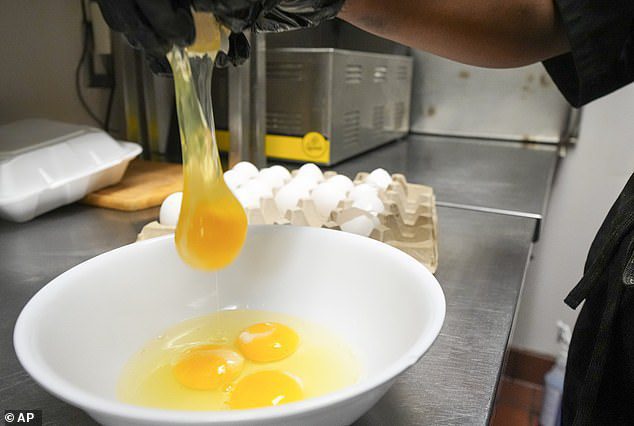
Breakfast enthusiasts across the United States are facing a significant challenge, as the demand for breakfast options surges, coinciding with skyrocketing egg prices.
Currently, egg prices have reached unprecedented highs – with the cost of a dozen eggs soaring to nearly $10. A major factor contributing to this increase is the relentless avian flu outbreak affecting poultry production.
Moreover, the growing trend of dining out for breakfast is also playing a significant role in creating shortages and driving up prices.
Breakfast culture has exploded across American restaurants. For example, First Watch, a popular breakfast, brunch, and lunch chain, has nearly quadrupled its locations from just over 140 to 570 in the past decade.
Similarly, Eggs Up Grill has expanded from 26 restaurants in 2018 to 90 locations across nine southern states, while Another Broken Egg Café in Florida proudly opened its 100th restaurant last year.
The fast-food sector is also embracing more breakfast items. Starbucks, which introduced egg bites in 2017, now features a breakfast menu with 12 egg-based dishes. Meanwhile, Wendy’s has brought back breakfast options, offering 10 egg-centric items.
The breakfast trend is evident. According to Yelp, 6,421 new breakfast and brunch establishments opened in the U.S. last year—an increase of 23% since 2019.

Chris Barton cracks eggs into a bowl at the Pepper Pod Restaurant, Thursday, Feb. 13, 2025, Newport, Ky. (AP Photo/Carolyn Kaster)
If not for the severe avian flu situation, egg producers could likely meet the current demand levels. However, this ongoing outbreak has so far led to the culling of nearly 159 million birds, including around 47 million since early December, resulting in a tighter supply and ultimately higher prices.
As of January, the average egg price in the U.S. hit a staggering $4.95 per dozen, compared to $2.50 a year prior.
Data on the percentage of eggs consumed in U.S. restaurants versus grocery stores or food manufacturers isn’t widely available.
U.S. Foods, a restaurant supplier, and Cal-Maine Foods, the largest producer of shell eggs in the nation, have yet to comment on the situation.
Nonetheless, it is clear that restaurant demand for eggs is on the rise.
Foot traffic in U.S. restaurants has increased dramatically for breakfast services since 2019, with pre-lunch visits accounting for 21% of all restaurant traffic in 2024, according to market research company Circana.
Breakfast sandwiches have emerged as the top order during morning visits, with approximately 70% of these sandwiches featuring eggs, as noted by Circana.

An egg on a mural displaying breakfast items as Teaira Booker sweeps, at The Breakfast Brothers restaurant, Wednesday, Feb. 12, 2025, in Arlington, Texas. (AP Photo/Julio Cortez)

Johkiya Pierre holds a carton of eggs while preparing a fresh omelette at The Breakfast Brothers restaurant, Wednesday, Feb. 12, 2025, in Arlington, Texas. (AP Photo/Julio Cortez)

A double-smoked bacon, cheddar & egg sandwich from the Starbucks All-Day Breakfast menu is pictured in Streetsboro, Ohio, Wednesday, Feb. 12, 2025. (AP Photo/Sue Ogrocki)
According to Ricky Richardson, CEO of Eggs Up Grill, the demand for breakfast spots soared after the pandemic as people sought comfort and connection.
As inflation drives food prices higher, diners are viewing breakfast and lunch as more budget-friendly meal options.
This rise in restaurant demand marks a significant shift from the pandemic era when many establishments temporarily closed and began selling food to home consumers to sustain their revenue.
As a result, households stocked up on eggs even while restaurants faced reduced demands, according to Brian Earnest, an economist specializing in animal proteins at CoBank.
The resurgence of egg consumption is reversing a long-term decline in the industry.
For over 50 years, U.S. egg consumption had fallen, reaching a low of 247 eggs per person in 2008, as reported by the U.S. Department of Agriculture.
Recent nutritional research and marketing have shifted perceptions, leading egg consumption to rebound to an estimated equivalent of 292 eggs per person in 2019.

Eggs being prepared for an omelette at The Breakfast Brothers restaurant on February 12, 2025, in Arlington, Texas. (AP Photo/Julio Cortez)
“Consumers associate eggs with freshness, so dishes featuring eggs signal quality,” says Earnest.
Prior to the pandemic and avian flu disruptions, the USDA had projected a consistent rise in egg consumption among Americans.
However, by 2023, per capita consumption had dipped again to 249 eggs.
Additional trends are complicating the egg market. In light of animal welfare concerns, companies such as McDonald’s have transitioned to solely sourcing cage-free eggs, which narrows their purchasing options.
Several states, including California and Colorado, have enacted legislation requiring that egg sales only include cage-free products.
This has made the market dynamics far more intricate than they were two decades ago, according to Earnest.
Increased egg prices are impacting restaurants severely. Last week, national wholesale prices for eggs averaged $7.34 per dozen, according to the U.S. Department of Agriculture.
This figure is up 51% from the start of the year. Wholesale prices often exceed retail costs, as grocery stores use eggs as a loss leader to attract customers.

Egg prices are now outpacing inflation, largely due to the avian flu crisis.

Chef Pato Aianel preparing an omelet at Eggs Works restaurant on February 13, 2025, in Las Vegas. (AP Photo/Ty ONeil)

Retailers like Costco and Trader Joe’s have restricted egg sales amid increasing demand.
In response to the rising prices, some chains, like Waffle House, have implemented a surcharge on menu items containing eggs. Others may opt for alternatives like tapioca starch or eliminate certain egg dishes altogether, according to Phil Kafarakis, president and CEO of the International Foodservice Manufacturers Association.
Chris Tomasso, president and CEO of First Watch, emphasized that eggs are vital to the chain’s menu, as they feature prominently in most offerings, both as standalone and as ingredients. Fortunately, the establishment has so far avoided passing on higher costs to customers.
In an effort to mitigate the situation, First Watch is also increasing the portion sizes of non-egg dishes like meats and potatoes.
Concerns remain that the avian flu could continue to adapt and affect cattle populations. The beef and cattle sectors are already experiencing notable price fluctuations due to diseased livestock, evolving consumer demands, tariffs with neighboring countries, and shifting restaurant menus.
Despite these challenges, restaurants aim to maintain customer satisfaction without introducing excessive surcharges.
Ricky Richardson from Eggs Up Grill shared that he recently consulted franchisees about adding an egg surcharge, but they collectively decided against it.
“Eggs have always been, and will continue to be, a staple of American cuisine,” Richardson stated.









